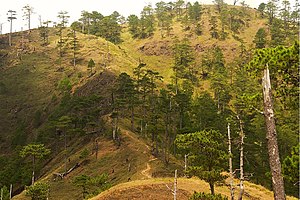Note: This is a project under development. The articles on this wiki are just being initiated and broadly incomplete. You can Help creating new pages.
Pinus khasya
Pinus kesiya is a fairly fast-growing evergreen, coniferous tree. It can grow up to a height of 45 metres tall. The crown is pyramidal when young, becoming rounded with age. It has a straight, cylindrical bole that is free of branches for 15 - 20 metres and is up to 100 cm in diameter.
Contents
- 1 Uses
- 2 Parts Used
- 3 Chemical Composition
- 4 Common names
- 5 Properties
- 6 Habit
- 7 Identification
- 8 List of Ayurvedic medicine in which the herb is used
- 9 Where to get the saplings
- 10 Mode of Propagation
- 11 How to plant/cultivate
- 12 Commonly seen growing in areas
- 13 Photo Gallery
- 14 References
- 15 External Links
Uses
Bladder complaints, Kidney complaints, Rheumatic affections, Respiratory complaints, Coughs, Colds, Influenza.[1]
Parts Used
Wood.
Chemical Composition
It contains high β-pinene, high longifolene, and low β-phellandrene content.[2]
Common names
| Language | Common name |
|---|---|
| Kannada | |
| Hindi | |
| Malayalam | |
| Tamil | |
| Telugu | |
| Marathi | |
| Gujarathi | |
| Punjabi | |
| Kashmiri | |
| Sanskrit | |
| English |
Properties
Reference: Dravya - Substance, Rasa - Taste, Guna - Qualities, Veerya - Potency, Vipaka - Post-digesion effect, Karma - Pharmacological activity, Prabhava - Therepeutics.
Dravya
Rasa
Guna
Veerya
Vipaka
Karma
Prabhava
Habit
Identification
Leaf
| Kind | Shape | Feature |
|---|---|---|
Flower
| Type | Size | Color and composition | Stamen | More information |
|---|---|---|---|---|
| {{{5}}} |
Fruit
| Type | Size | Mass | Appearance | Seeds | More information |
|---|---|---|---|---|---|
Other features
List of Ayurvedic medicine in which the herb is used
Where to get the saplings
Mode of Propagation
[[:Category:Index of Plants which can be propagated by |]]
How to plant/cultivate
A plant of the moist tropics and subtropics, where it is found at elevations from 300 - 2,700 metres. Very adaptable to different ecological conditions, though it does not grow well in tropical lowlands.[4]
Commonly seen growing in areas
Found in a wide range of forest, Savannah habitats.
Photo Gallery
References
- ↑ Indian Medicinal Plants by C.P.Khare
- ↑ Chemical constituents
- ↑ [Morphology]
- ↑ Cultivation
External Links
- Ayurvedic Herbs known to be helpful to treat Bladder complaints
- Ayurvedic Herbs known to be helpful to treat Kidney complaints
- Ayurvedic Herbs known to be helpful to treat Rheumatic affections
- Ayurvedic Herbs known to be helpful to treat Respiratory complaints
- Ayurvedic Herbs known to be helpful to treat Coughs
- Ayurvedic Herbs known to be helpful to treat Colds
- Ayurvedic Herbs known to be helpful to treat Influenza
- Herbs with Wood used in medicine
- Habit - Evergreen tree
- Index of Plants which can be propagated by
- Herbs that are commonly seen in the region of Found in a wide range of forest
- Herbs that are commonly seen in the region of Savannah habitats
- Herbs
- Pages without herbs images





